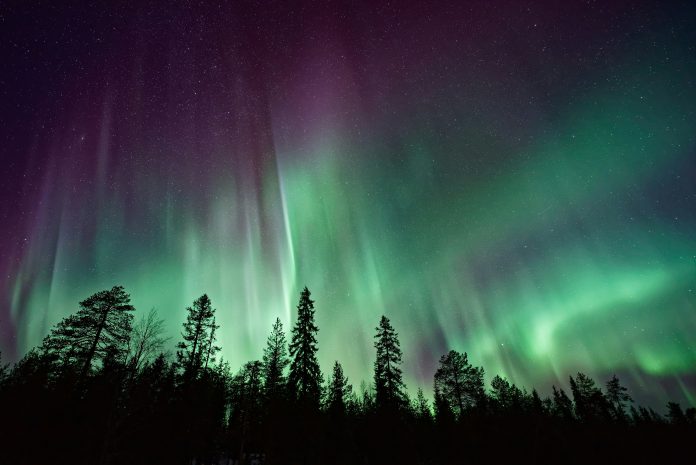A failed experiment with a northern lights simulator and a particularly potent cup of Swedish coffee had thrown young physicist Elsa into a vortex she didn’t understand. When her vision cleared, she was no longer in her Stockholm lab, but standing knee-deep in snow in a silent, ancient forest. The air was so crisp it felt like a physical presence, and the only light came from a blanket of stars so vivid they seemed close enough to touch. She had been thrust into the heart of a classic Swedish winter.
A Fika with the Frost
Shivering, Elsa stumbled upon a trail and followed it to a clearing where a small, red wooden hut stood, smoke curling from its chimney. The sign read “Mysstuga“. Peering inside, she saw a woman in traditional folk dress pulling a golden kanelbulle from an oven, filling the hut with the scent of cardamom and cinnamon. The woman, introducing herself as Astrid, welcomed Elsa without a hint of surprise, as if time-traveling physicists were a daily occurrence. “You look like you need a fika,” Astrid said, pouring strong coffee and serving the bun.
As they sat, Astrid explained the unwritten rules of Swedish life: the sacredness of the coffee break, the art of creating mysig coziness to combat the dark winters, and the importance of lagom—the philosophy of “not too much, not too little, just the right amount.” Elsa, used to extremes in her research, found the concept baffling yet beautiful.
A Sauna Sacrifice and a Northern Nocturne
Later, Astrid led her to a bastu by a frozen lake. “To understand Sweden, you must experience the sauna,” she declared. After sweating in the intense, wood-fired heat, Astrid ran outside and dove into a hole cut in the ice. Gasping, Elsa followed. The shock of the freezing water was electrifying, followed by a surreal, tingling warmth that spread through her entire body. It was a ritual of extremes that somehow embodied perfect balance—lagom in its purest, most brutal form.
That night, the aurora borealis erupted overhead. Rivers of green and purple light danced across the sky, silent and majestic. Astrid called it the “fox fires,” a nod to the Swedish folklore that suggests the lights are caused by a magical fox swishing its tail. Elsa, who had tried to replicate this in a lab, felt a profound humility. She was witnessing not a scientific phenomenon, but pure magic.
A Troll Hunt and a Culinary Quest
The next day, they hiked through Tyresta National Park, a vast wilderness of pine and spruce. Astrid pointed out strange rock formations. “These are troll toes,” she said with a wink. “They turned to stone when caught in the sunlight.” Elsa laughed, but part of her wondered, her scientific certainty beginning to crack in this enchanted landscape.
Their journey continued to a Julmarknad in a small village. The air was filled with the smell of glögg and pepparkakor. Elsa tried sill (pickled herring) and prinsesstårta, the iconic green princess cake. It was a culinary world away from her lab’s protein bars. She learned of Allemansrätten, the right of public access that allows everyone to roam freely in nature, a concept that felt like the ultimate freedom.
The Midnight Sun Conclusion
As suddenly as she arrived, Elsa felt the familiar pull of the vortex. She said a hurried goodbye to Astrid, clutching the Dala horse trinket her friend had given her. In an instant, she was back in her sterile lab, the smell of snow and pine replaced by the scent of ozone and electronics.
On her desk, next to a half-finished equation, sat the small, wooden Dala horse. And in her notebook, a new line of inquiry was scribbled: “The Physics of Lagom: Seeking Balance in Chaotic Systems.” She had gone to the Arctic to study the aurora, but she returned with a far greater discovery: that mysig, fika, and lagom were not just words, but the fundamental principles of a life well-lived. The adventure was over, but her journey had just begun.



